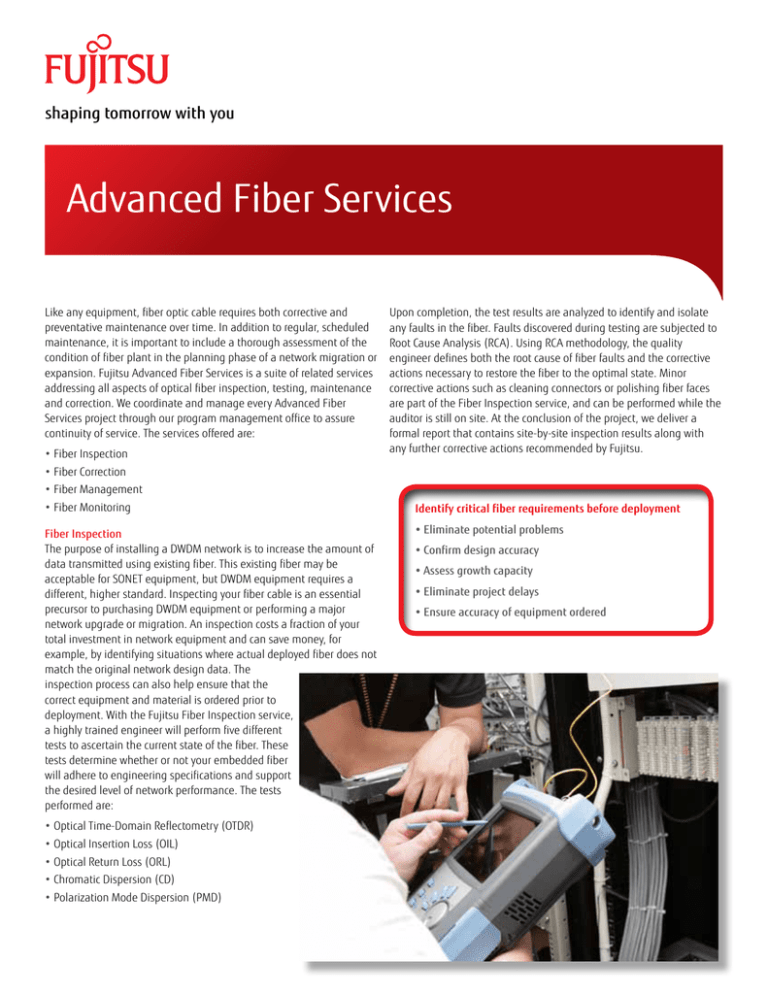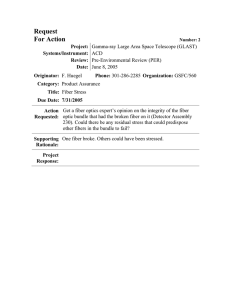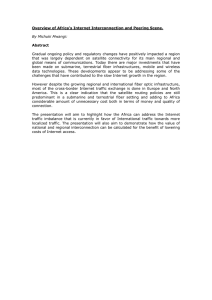
shaping tomorrow with you
Advanced Fiber Services
Like any equipment, fiber optic cable requires both corrective and
preventative maintenance over time. In addition to regular, scheduled
maintenance, it is important to include a thorough assessment of the
condition of fiber plant in the planning phase of a network migration or
expansion. Fujitsu Advanced Fiber Services is a suite of related services
addressing all aspects of optical fiber inspection, testing, maintenance
and correction. We coordinate and manage every Advanced Fiber
Services project through our program management office to assure
continuity of service. The services offered are:
• Fiber Inspection
Upon completion, the test results are analyzed to identify and isolate
any faults in the fiber. Faults discovered during testing are subjected to
Root Cause Analysis (RCA). Using RCA methodology, the quality
engineer defines both the root cause of fiber faults and the corrective
actions necessary to restore the fiber to the optimal state. Minor
corrective actions such as cleaning connectors or polishing fiber faces
are part of the Fiber Inspection service, and can be performed while the
auditor is still on site. At the conclusion of the project, we deliver a
formal report that contains site-by-site inspection results along with
any further corrective actions recommended by Fujitsu.
• Fiber Correction
• Fiber Management
• Fiber Monitoring
Identify critical fiber requirements before deployment
Fiber Inspection
The purpose of installing a DWDM network is to increase the amount of
data transmitted using existing fiber. This existing fiber may be
acceptable for SONET equipment, but DWDM equipment requires a
different, higher standard. Inspecting your fiber cable is an essential
precursor to purchasing DWDM equipment or performing a major
network upgrade or migration. An inspection costs a fraction of your
total investment in network equipment and can save money, for
example, by identifying situations where actual deployed fiber does not
match the original network design data. The
inspection process can also help ensure that the
correct equipment and material is ordered prior to
deployment. With the Fujitsu Fiber Inspection service,
a highly trained engineer will perform five different
tests to ascertain the current state of the fiber. These
tests determine whether or not your embedded fiber
will adhere to engineering specifications and support
the desired level of network performance. The tests
performed are:
•E
liminate potential problems
• Optical Time-Domain Reflectometry (OTDR)
• Optical Insertion Loss (OIL)
• Optical Return Loss (ORL)
• Chromatic Dispersion (CD)
• Polarization Mode Dispersion (PMD)
• C onfirm design accuracy
•A
ssess growth capacity
•E
liminate project delays
• Ensure accuracy of equipment ordered
Assess and optimize your optical fiber
Improve performance of existing optical fiber
• Match fiber quality to service requirements
• Improve fiber utilization and capacity capabilities
• Optimize network performance
• Prioritize fibers available
• Verify specifications
• Ensure bandwidth capacity
• Detect and locate faults
Fiber Correction
In some instances, faults found during the Fiber Inspection process
cannot be addressed immediately. We address these faults through the
Fiber Correction service. The Fiber Correction service rectifies faults
within a Central Office (CO) or in outside-plant facilities. Fujitsu
engineers consult with you to determine and plan a course of action
along with a scope of work. We then deploy the right engineering staff
to restore the optical fiber to optimal condition.
Fiber Monitoring
Early detection of faults is crucial to maintaining SLAs and ensuring
customer satisfaction. A real time monitoring service, such as the
Fujitsu Fiber Monitoring service, can reduce the impact of failures by
reducing repair and response times. The service uses a dedicated piece
of equipment to monitor the health of the fiber bundle. The results are
fed back to a central server and appear on a desktop via a Web client.
Monitoring one fiber allows you to detect more than 80% of the cable
faults.
This service can be deployed in one of two ways: out-of service
monitoring or in-service monitoring. Out-of-service monitoring uses a
spare fiber to monitor the fibers within a cable. No link modification is
required and any test wavelength can be used. In-service monitoring
provides health information in situations where all the fibers are being
used to carry traffic. Additional passive components allow the device to
monitor fiber health without affecting signal loss.
Fujitsu can sell and install the fiber monitoring equipment for
customers capable of monitoring their own equipment. The Fiber
Monitoring capability is also available as part of a Fujitsu Managed
Network Solution.
Fiber Management
Certain faults and inefficiencies in fiber systems derive from incorrect
installation and management of the fiber itself. Substandard
installations and cable dressing degrade the performance of your fiber
and can result in lost revenue and increased downtime.
Working from the standards defined in Section 22 of Telcordia GR-1275,
Fujitsu quality engineers assess the current state of fiber plant routing
and management. The engineers scrutinize aspects of the installation,
including fiber bend radii, fiber routing through overhead racks, and
the general state of the fiber. Upon completing the audit, the customer
receives a detailed site-by site analysis with photographic evidence,
along with a complete remediation plan.
Fujitsu Network Communications Inc.
2801 Telecom Parkway, Richardson, TX 75082
Tel: 800.777.FAST (3278) Fax: 972.479.6900
us.fujitsu.com/telecom
© Copyright 2011 Fujitsu Network Communications Inc.
FUJITSU (and design)® and “shaping tomorrow with you” are trademarks of Fujitsu Limited. All Rights Reserved. All other trademarks are the property of their respective owners. Configuration requirements for certain uses are described in the product documentation. Features and specifications subject to change without notice.
1.0/01.11






